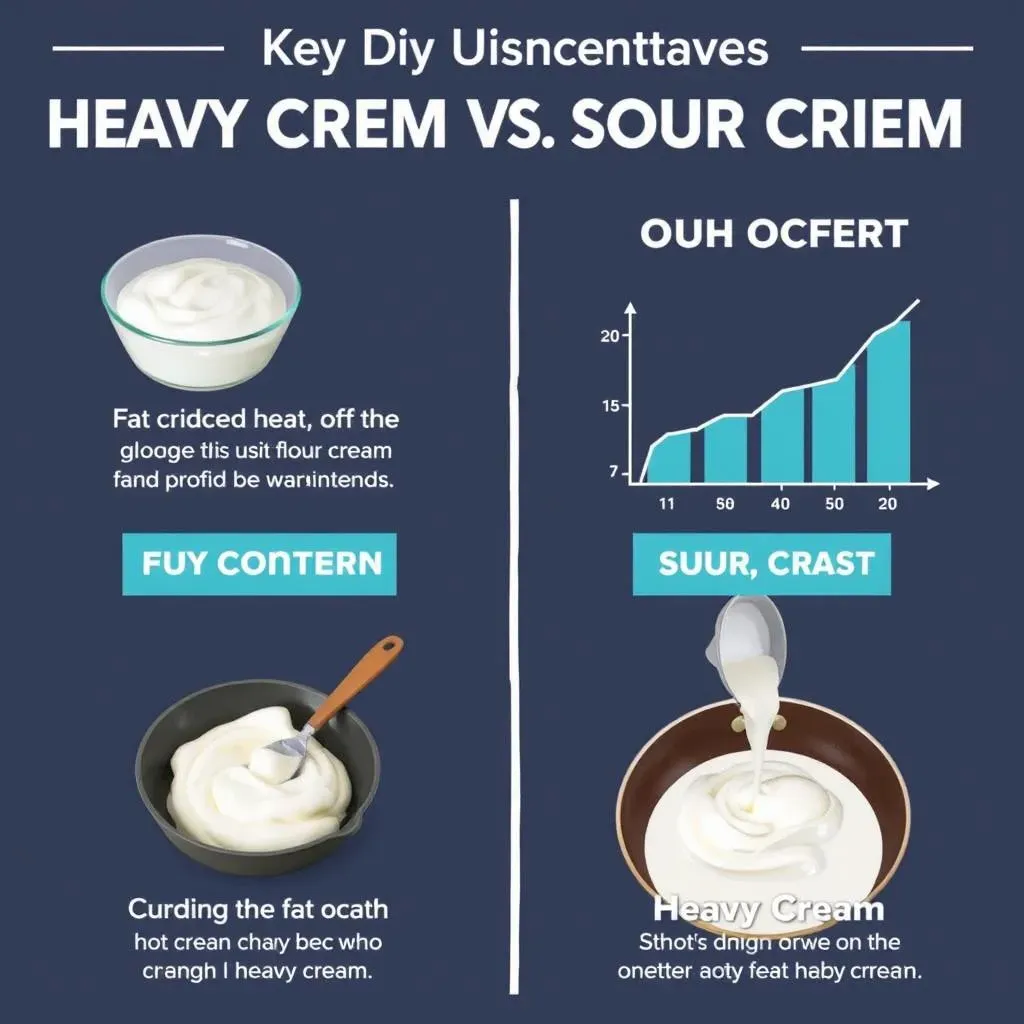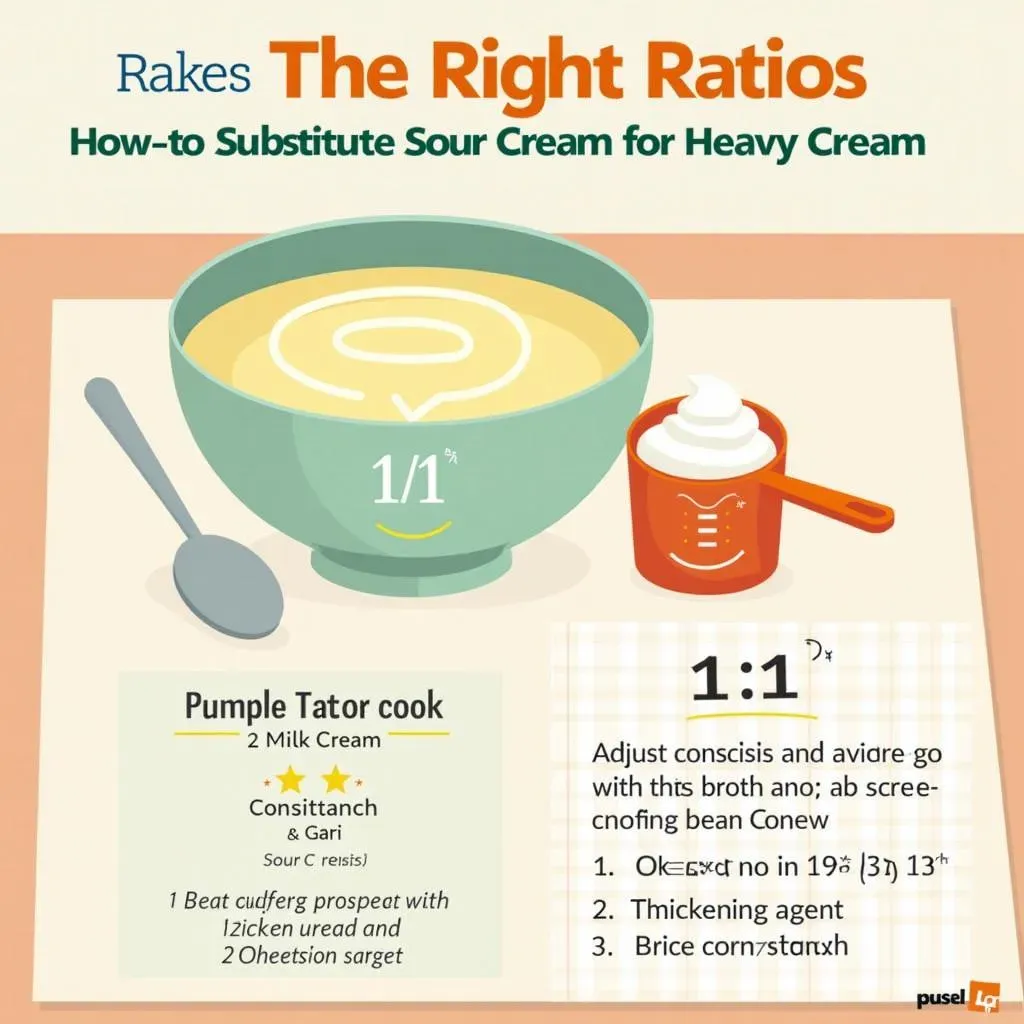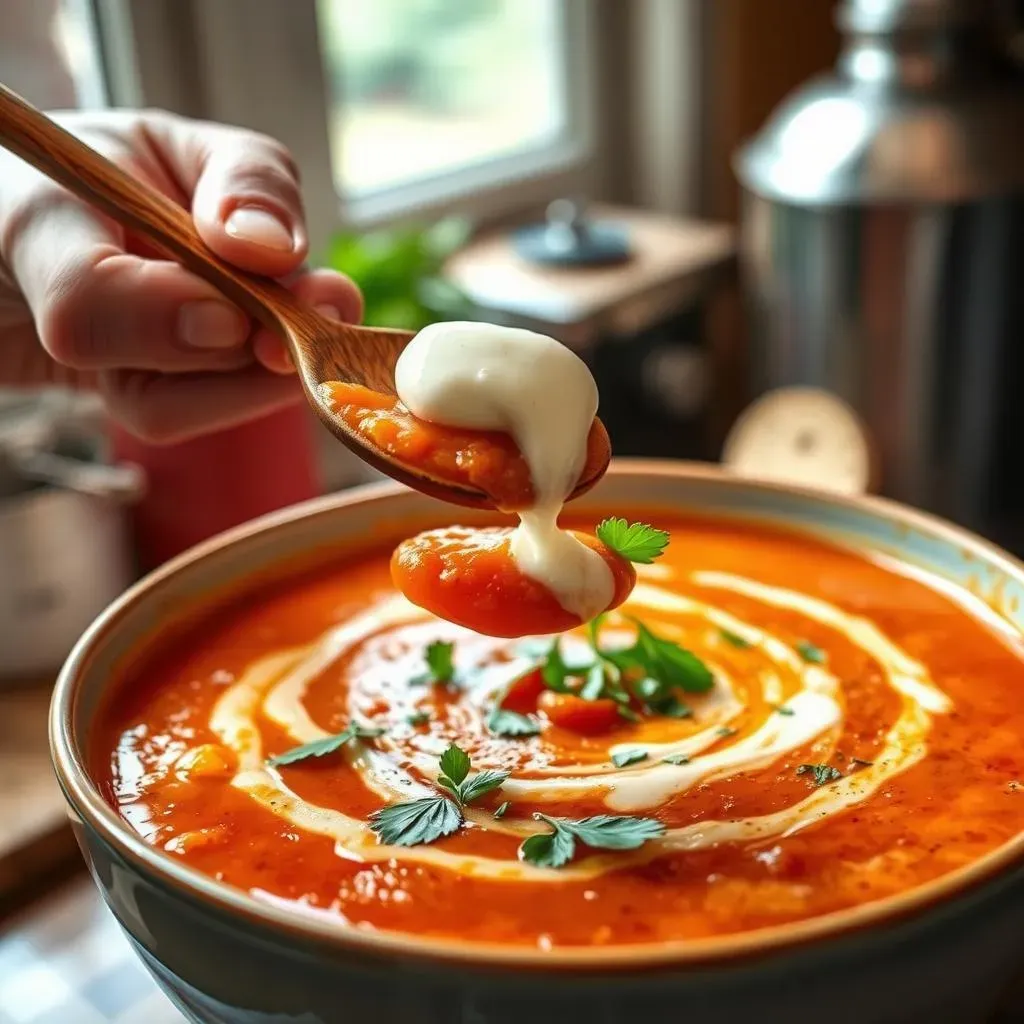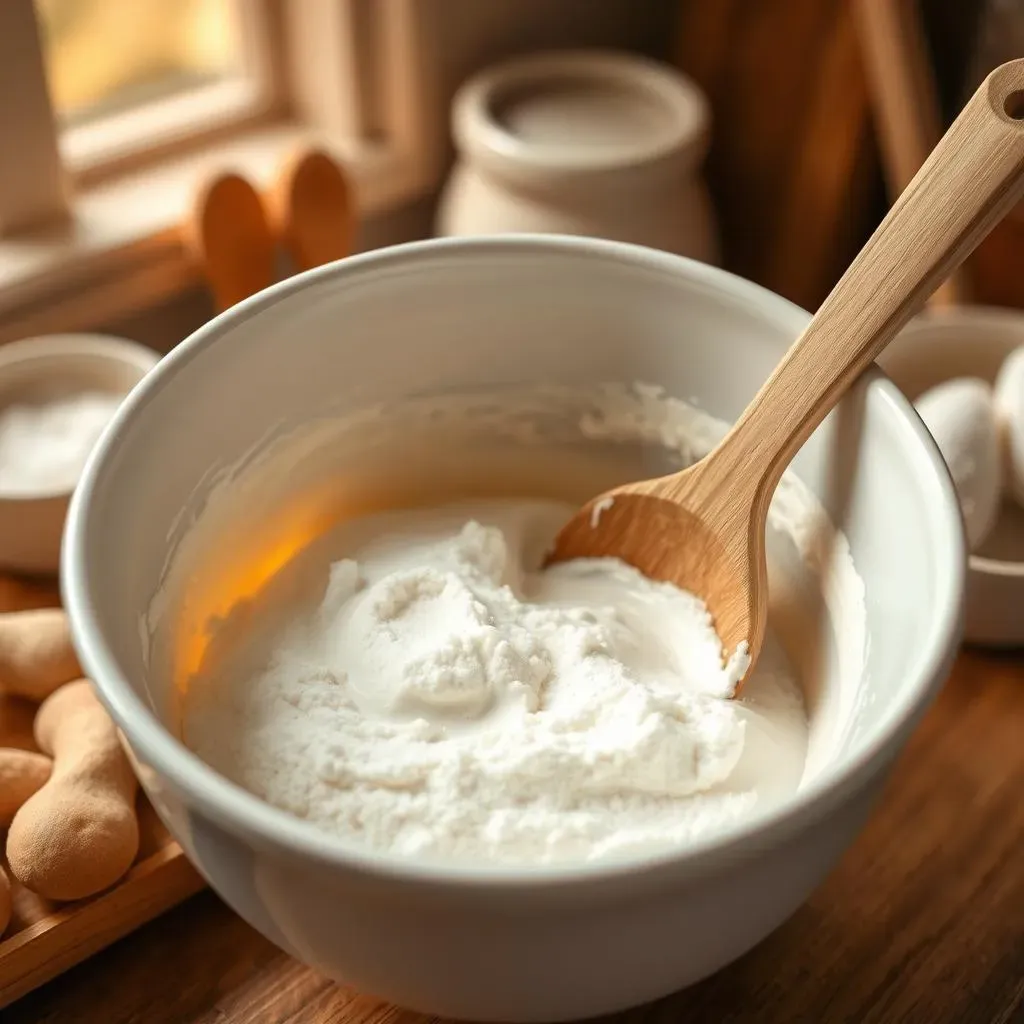Table of Contents
Ever find yourself mid-recipe, only to realize you're fresh out of heavy cream? It's a kitchen crisis we've all faced, but don't worry, there's a tangy hero ready to step in: sour cream. Yes, that dollop of goodness in your fridge can actually be a pretty good stand-in for heavy cream in many dishes. But before you go swapping willy-nilly, let's get into the nitty-gritty of how to substitute sour cream for heavy cream. This isn't a one-size-fits-all situation; there are some things you need to know. We'll explore when this swap works best, the correct ratios to use so you don't end up with a culinary catastrophe, and how the flavor and texture might change. Whether you're whipping up a creamy soup or attempting a delicate dessert, understanding these substitutions will make you a more confident cook. So, let’s explore the tangy truth about this substitution and rescue your recipe.
Understanding When to Substitute Sour Cream for Heavy Cream

Understanding When to Substitute Sour Cream for Heavy Cream
The Fat Factor: Why It Matters
Okay, so you're staring at that recipe, heavy cream is nowhere to be found, and sour cream is looking mighty tempting. But can they really swap places? The key thing to remember is fat. Heavy cream is all about that high-fat content, which gives it that rich, velvety texture. Sour cream has fat, too, but it's usually a bit lower. This difference affects how your dish will turn out. If you're making something that really relies on that super-rich, thick texture, like a decadent chocolate ganache, substituting sour cream might not give you the result you're hoping for.
Think of it like this: heavy cream is like a luxurious velvet blanket, while sour cream is more like a cozy fleece. Both are great, but they have different feels and purposes. So, before you make the swap, consider what texture you're going for. Will it be a light and airy sauce, or a thick and luscious gravy? Knowing this is half the battle.
Heat Sensitivity: A Sour Cream Caveat
Now, here's a little secret about sour cream: it can be a bit of a drama queen when it comes to heat. Unlike heavy cream, which can handle high temperatures without breaking a sweat, sour cream can curdle if it gets too hot too fast. This means that if you're adding it to a simmering sauce, you need to be gentle. Adding a dollop of cold sour cream directly into a hot pan is a recipe for a grainy mess. Instead, you want to temper it. Take a spoonful of your hot sauce and mix it with the sour cream in a separate bowl first, and then add this mixture to the rest of the sauce. This way, the sour cream warms up gradually and avoids the curdling catastrophe.
Heavy Cream | Sour Cream |
|---|---|
High fat content | Lower fat content |
Stable at high temperatures | Can curdle at high temperatures |
Rich, velvety texture | Tangy, slightly thinner texture |
Flavor Profiles: Tang vs. Rich
Finally, let's talk flavor. Heavy cream is pretty neutral, adding richness without changing the overall taste of your dish. Sour cream, on the other hand, brings a noticeable tang. This can be a delicious addition in some cases, like in a creamy tomato soup or a spicy chili. But if you're making something delicate where you want the other flavors to shine, the tang of sour cream might be a bit overpowering. It's all about balancing the flavors. If the tang works with your dish, then go for it! If you're not sure, start with a small amount, taste, and then add more as needed. It’s always better to start slow than to commit to a full-on sour cream takeover.
So, before you reach for the sour cream, think about the texture, the heat, and the flavor. With a little bit of know-how, you can make the right choice for your recipe.
The Right Ratios: How to Substitute Sour Cream for Heavy Cream

The Right Ratios: How to Substitute Sour Cream for Heavy Cream
The 1:1 Rule (With a Grain of Salt)
Alright, so you've decided to go for it and swap sour cream for heavy cream. Now comes the tricky part: how much to use. The general rule of thumb you'll often hear is a 1:1 ratio. This means if your recipe calls for one cup of heavy cream, you'd use one cup of sour cream. Sounds simple, right? Well, it's a good starting point, but it's not always perfect. Remember, sour cream has less fat and a different consistency than heavy cream. This means your final dish might not be exactly the same as if you'd used heavy cream. It might be a bit thinner and have that characteristic tang. However, for many recipes, this 1:1 swap works just fine.
Think of this rule as a guideline, not a strict law. Consider how much the recipe depends on the thickness and richness of the heavy cream. If it's a crucial part of the dish, start with the 1:1 ratio but be prepared to adjust a bit. If it's just a bit of cream for a sauce, a straight swap should be totally fine. The best way to figure it out is to experiment. Start with the 1:1 ratio, taste, and then add more sour cream or some other liquid to get the consistency and flavor you're after. Don’t be afraid to trust your own taste buds!
Adjusting for Consistency
Now, let's talk about what to do if that 1:1 ratio isn’t quite cutting it. If you find your dish is too thick after adding the sour cream, you can thin it out with a bit of milk or broth. Add a tablespoon at a time until you reach the desired consistency. On the flip side, if you need to thicken things up, there are a few tricks you can use. You can reduce the sauce by simmering it gently or add a thickening agent like a cornstarch slurry (mix cornstarch with cold water before adding it to the hot sauce). If you are going to add flour, make sure you cook the flour to remove the raw flour taste. You can also use a bit of cream cheese to add a bit more fat and richness. This will help you get closer to the texture that heavy cream would have provided. Remember, cooking is all about adjusting and adapting, so don't be afraid to experiment until you find the perfect balance.
And remember, the goal here isn't to perfectly replicate heavy cream. It's about making a delicious dish with what you have available. So, embrace the slight differences and get creative!
Problem | Solution |
|---|---|
Dish is too thick | Thin with milk or broth |
Dish is too thin | Reduce by simmering or add a thickener |
Missing richness | Add a touch of cream cheese |
Savory Success: Using Sour Cream in Place of Heavy Cream

Savory Success: Using Sour Cream in Place of Heavy Cream
Soups and Sauces: A Tangy Twist
Okay, so where does sour cream really shine in the savory world? Think soups and sauces! It's like a secret weapon for adding a bit of zing and creaminess all at once. Imagine a tomato soup that's just a little too flat. A dollop of sour cream not only makes it richer but also adds a lovely tang that cuts through the richness, making it way more interesting. The same goes for creamy vegetable soups. Instead of heavy cream, try sour cream for a lighter, brighter flavor. Just remember our heat sensitivity rule. Don't just dump it in a boiling pot. Temper it first, by mixing some of the hot soup with the sour cream before adding it to the rest. This will keep it smooth and prevent any curdling.
And what about sauces? Sour cream can be a fantastic addition to sauces for pasta, meats, and even vegetables. It adds a creamy texture that clings beautifully to the food. Plus, that slight tang can really enhance the other flavors in your dish. Think of a creamy dill sauce for salmon or a tangy mushroom sauce for steak. These are places where sour cream can really shine. You can even use sour cream as a base for a quick dipping sauce for veggies or chips. It's versatile, delicious, and a great way to use up that leftover container in the fridge.
Chilis, Stews, and Beyond
Let's move beyond soups and sauces, shall we? Sour cream is a fantastic addition to heartier dishes like chili and stews. It adds a creamy coolness that contrasts beautifully with the warmth and spice of these dishes. A dollop of sour cream on top of a bowl of chili isn't just for looks; it’s a flavor bomb. It balances out the heat and adds a velvety texture that takes it to another level. You can stir it in at the end for a creamier consistency, or simply use it as a garnish. The same goes for stews. Whether it's a rich beef stew or a spicy chicken stew, a bit of sour cream will definitely give it extra depth.
But don’t stop there! Sour cream can also be a great addition to mashed potatoes, creating a tangy and fluffy side dish. It’s also amazing in casseroles, adding moisture and a slight zing. And think about it – a creamy coleslaw or potato salad? Sour cream can be the star ingredient. The possibilities are really endless. The key is to experiment and see how the tang and texture of sour cream can elevate your favorite savory dishes. Just remember, a little goes a long way, so start with a small amount and add more to your liking.
Dish Type | How Sour Cream Helps |
|---|---|
Soups | Adds creaminess and tang, lightens flavor |
Sauces | Creates a rich, clingy texture and flavor |
Chilis/stews | Balances heat and adds creamy coolness |
Sides (mashed potatoes, coleslaw) | Adds tang and moisture |
Baking with Sour Cream: A Heavy Cream Substitute?

Baking with Sour Cream: A Heavy Cream Substitute?
The Baking Battlefield: When to Use Sour Cream
Alright, let's talk baking. Can sour cream really step up and replace heavy cream in your cakes and cookies? The answer is, it depends! Unlike savory dishes, where the tangy flavor can be a welcome addition, in baking, that tang can sometimes throw things off. However, sour cream can be a fantastic addition in certain baked goods. Think about recipes where you want a moist, tender crumb, like in coffee cakes or muffins. The acidity in sour cream helps to break down gluten, leading to a softer texture. This makes it a great substitute in recipes where you might normally use buttermilk or yogurt. But, if you're making something that needs a very rich, dense, and buttery texture, like a classic buttercream frosting or a super decadent chocolate cake, sour cream might not be the best choice. In those cases, the lower fat content and the tang will definitely make a difference.
It's also important to consider the other ingredients in your recipe. If you already have a lot of acidic ingredients, adding sour cream might make the flavor too sharp. On the other hand, if you have a lot of sweet ingredients, the tang of sour cream can help balance the flavors. It’s all about understanding how the flavors and textures work together. So, before you swap out the heavy cream, think about what you're trying to achieve. Do you want something light and tangy, or something rich and decadent? This will guide you to the right choice.
Navigating Texture and Flavor Changes
So, you've decided to give sour cream a try in your baking. Now, let’s talk about what to expect. First off, you'll notice that baked goods made with sour cream tend to be more moist. This is because sour cream has a higher water content compared to heavy cream. This can be a good thing, especially if you're making something that tends to dry out easily. However, this extra moisture can also mean that your baked good might be a bit denser. To counter this, you might consider adding a touch more leavening agent, like baking powder, to help it rise a bit higher. Also, remember that tang? It’s going to be there. In some recipes, it will be delicious, adding a subtle complexity. But, in others, it might be a bit too noticeable. You can try to balance it out with extra sugar or vanilla extract. But, if the recipe relies on a very delicate flavor profile, the tang might overpower it. Therefore, always taste and adjust as you go. Baking is a science, but it's also an art, and it's all about experimenting and finding what works best for you. Don't be afraid to try new things and see how sour cream can transform your favorite recipes. With a little bit of practice, you can become a master of the sour cream swap!
Baking Factor | Effect of Sour Cream |
|---|---|
Moisture | Increases moisture, can make baked goods denser |
Texture | Creates a softer, more tender crumb |
Flavor | Adds a noticeable tang |
Leavening | May need to adjust if you want to rise more |